
Kansas
The 5 Biggest State Tax Cuts for Millionaires this Year
October 16, 2025 • By Dylan Grundman O'Neill, Aidan Davis

Some states continue to hand out huge tax cuts to millionaires. The five largest tax cuts this year will cost states a total of $2.2 billion per year once fully implemented.
Tax Cuts Fail Again in Kansas and Wisconsin; Lawmakers Should Pivot to Proven Investments
March 6, 2024 • By Neva Butkus

The governors of both Kansas and Wisconsin recently stood up to legislators who tried to push through costly tax cuts that would overwhelmingly benefit the most well-off. Lawmakers in those states and others should shift their focus from expensive, top-heavy tax cuts to tried and true policies that help middle-class and low-income families.
AP News: Kansas Governor Vetoes Tax Cuts She Says Would Favor ‘Super Wealthy’
January 29, 2024
But the left-leaning Institute on Taxation and Economic Policy reported that even with the changes designed to benefit poorer taxpayers, 70% of the savings in raw dollars will go to the 20% of filers earning more than $143,000 a year.
Latest Kansas Tax Plan Would Provide an Estimated $875,000 Tax Cut to Charles Koch
January 22, 2024 • By Carl Davis, Neva Butkus
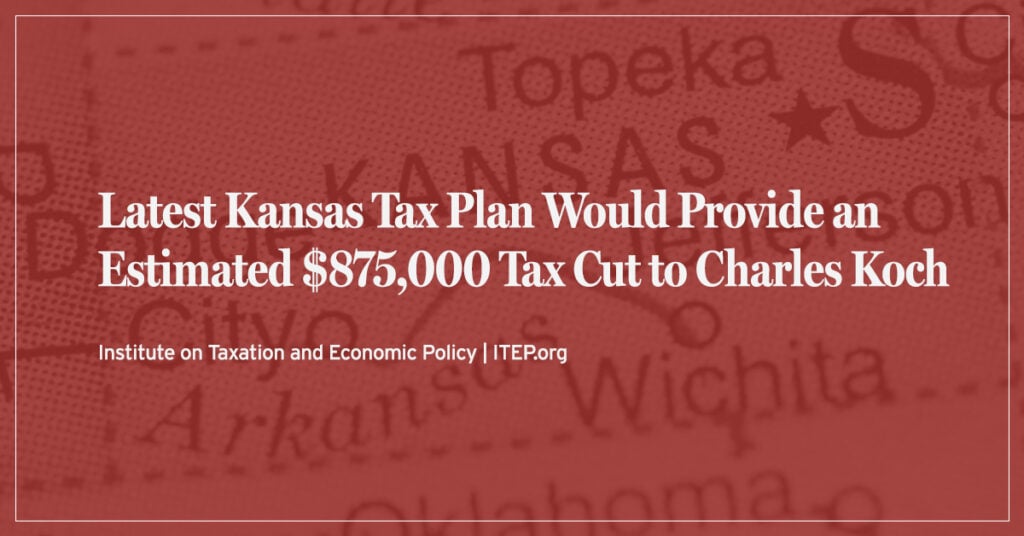
Last week, both houses of the Kansas legislature approved a significant tax cut centered around replacing the state’s graduated rate income tax structure with a flat tax instead. The bulk of this would flow to upper-income families, mostly through lowering the state’s top income tax rate from 5.7 to 5.25 percent. This tax cut would […]
Kansas: Who Pays? 7th Edition
January 9, 2024 • By ITEP Staff
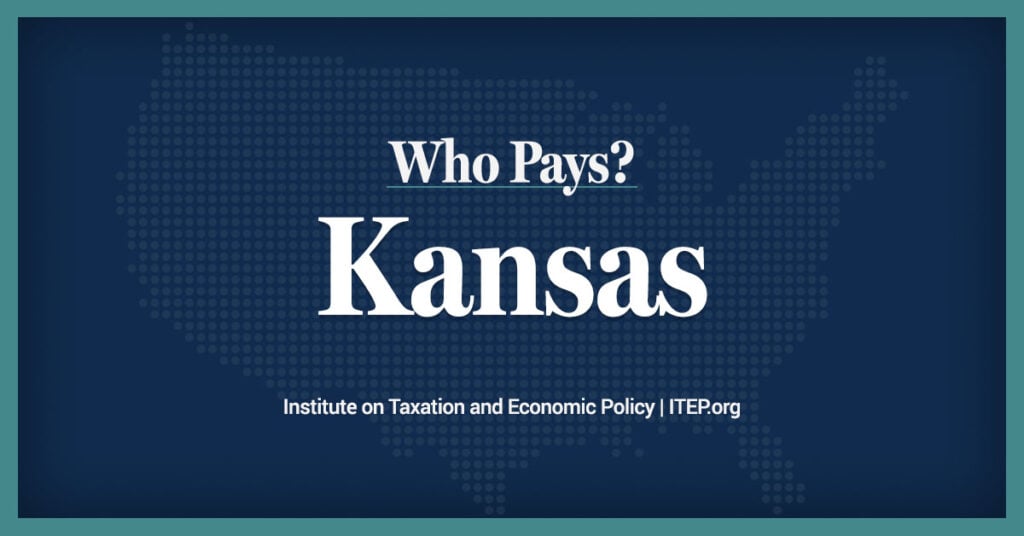
Kansas Download PDF All figures and charts show 2024 tax law in Kansas, presented at 2023 income levels. Senior taxpayers are excluded for reasons detailed in the methodology. Our analysis includes nearly all (99.9 percent) state and local tax revenue collected in Kansas. These figures depict Kansas’s grocery sales tax rate at its 2024 level […]
Kansas Action for Children: Flat Tax: Simple Doesn’t Mean Smart
February 16, 2023
The state has seen increased revenue in recent years, with the state budget including millions of dollars in surplus revenue. The temporary, higher receipts have led to several tax cut proposals. Now, some politicians and special business interest groups are proposing to use lingering budget surpluses to tilt the tax code even further in their favor. […]
Kansas Action for Children: Working Kansas Families Bear Brunt of Skewed Policies
February 26, 2021
In the midst of a global pandemic and recession, the Kansas Legislature shockingly continues to consider bills that will further lower the already low tax responsibilities of corporations and high-income Kansans. Lawmakers should reject legislation like Senate Bill 22 and instead work to enhance economic and racial equity through Kansas’s tax code. Our state’s leaders […]
Missouri’s Creative Approach to Ending the “Race to the Bottom” in State Business Taxes
July 10, 2019 • By Matthew Gardner
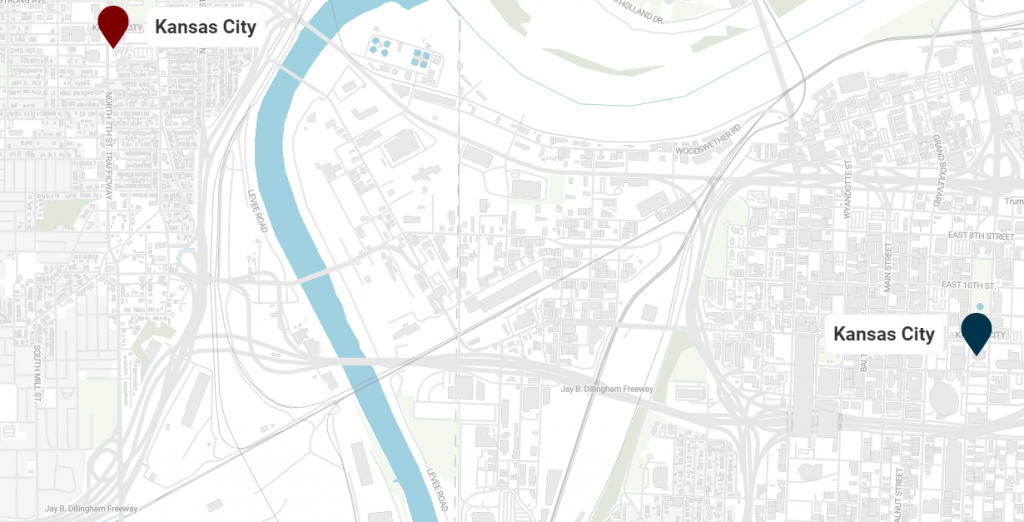
Each year, state and local governments spend billions of dollars on targeted tax incentives—special tax breaks ostensibly designed to encourage businesses to relocate, expand or simply stay where they are. A law enacted by the Missouri legislature creates a template for states to work bilaterally to put the brakes on the “race to the bottom” in state business taxes.
Kansas Center for Economic Growth: Kansans of Color Often Pay More Than Their Fair Share of Taxes
November 2, 2018
Kansans believe in fairness. However, a recent study by the Institute on Taxation and Economic Policy (ITEP) and the Kansas Center for Economic Growth finds that the lowest-income Kansans are contributing a higher share of their income to fund our priorities. Without an equitable tax structure, we will struggle to make necessary investments in great […]
Topeka-Capital Journal: New Study: Kansas’ Tax Policy Ranks as 23rd Most Regressive in the Nation
October 17, 2018
A 50-state study of tax systems found Kansas’ lowest-income residents pay 1.5 times more in taxes as a percent of income compared with the wealthiest residents, ranking the state 23rd in the nation on an equity index. “State lawmakers have control over how their tax systems are structured,” said Meg Wiehe, the institute’s deputy director and a study author. “They can and should enact more equitable tax policies that raise adequate revenue in a fair, sustainable way.”
Kansas Center for Economic Growth: New Analysis: Tax Reform Reduces Inequality for Kansans, but Low-Income Taxpayers Still Pay 1.5 Times the Rate Paid by the Richest
October 17, 2018
A new study released today by the Institute on Taxation and Economic Policy and the Kansas Center for Economic Growth finds that the lowest-income Kansans pay 1.5 times more in taxes as a percent of their income compared with the state’s wealthiest residents.
Kansas: Who Pays? 6th Edition
October 17, 2018 • By ITEP Staff
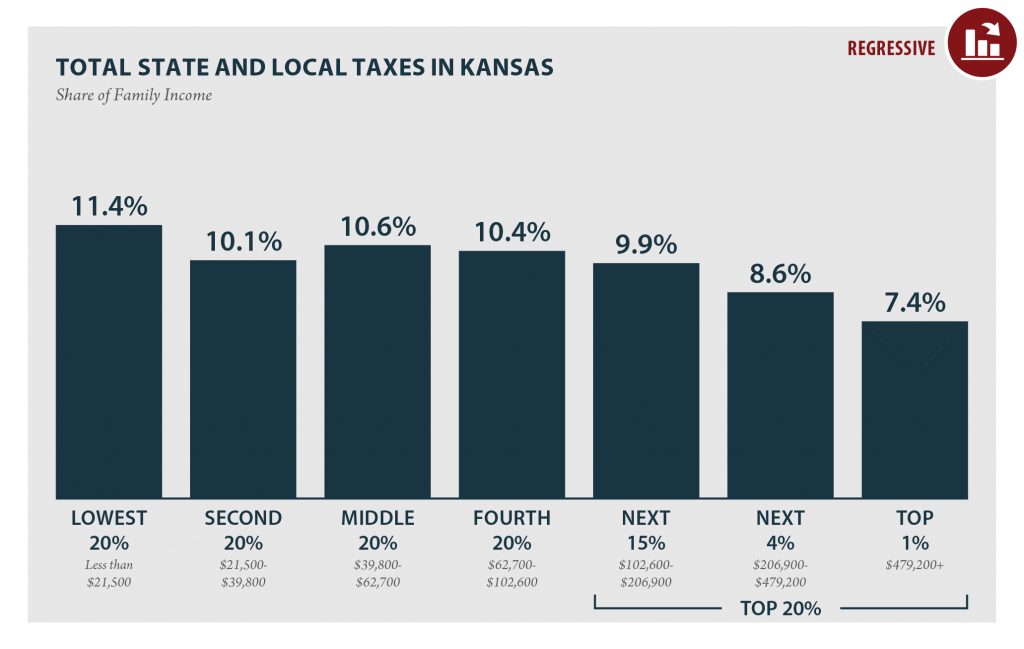
KANSAS Read as PDF KANSAS STATE AND LOCAL TAXES Taxes as Share of Family Income Top 20% Income Group Lowest 20% Second 20% Middle 20% Fourth 20% Next 15% Next 4% Top 1% Income Range Less than $21,500 $21,500 to $39,800 $39,800 to $62,700 $62,700 to $102,600 $102,600 to $206,900 $206,900 to $479,200 over $479,200 […]
Twelve States Offer Profitable Tax Shelter to Private School Voucher Donors; IRS Proposal Could Fix This
October 2, 2018 • By Carl Davis

A proposed IRS regulation would eliminate a tax shelter for private school donors in twelve states by making a commonsense improvement to the federal tax deduction for charitable gifts. For years, some affluent taxpayers who donate to private K-12 school voucher programs have managed to turn a profit by claiming state tax credits and federal tax deductions that, taken together, are worth more than the amount donated. This practice could soon come to an end under the IRS’s broader goal of ending misuse of the charitable deduction by people seeking to dodge the federal SALT deduction cap.
Tax Cuts 2.0 – Kansas
September 26, 2018 • By ITEP Staff
The $2 trillion 2017 Tax Cuts and Jobs Act (TCJA) includes several provisions set to expire at the end of 2025. Now, GOP leaders have introduced a bill informally called “Tax Cuts 2.0” or “Tax Reform 2.0,” which would make the temporary provisions permanent. And they falsely claim that making these provisions permanent will benefit […]
Kansas Center for Economic Growth: New KCEG Blog Series Documents Equity Issues Facing Kansas
February 15, 2018
systemic barriers facing Kansans can strengthen our state’s economy. Using data broken out by race and ethnicity, gender, and immigration status, the entries highlight areas for policymakers to address to ensure continued economic prosperity for every Kansan. Policy and research analyst Emily Fetsch examined data in recent reports from the Kansas Health Institute and the Institute on Taxation and Economic Policy.
Kansas Center for Economic Growth: New American immigrants in Kansas strengthen the economy
February 7, 2018
A recent report from the Institute of Tax and Economic Policy (ITEP) shows how undocumented immigrants in Kansas demonstrate their commitment to our state and increase state revenue through the taxes they pay. Read more here
Kansas Center for Economic Growth: New American Immigrants in Kansas Strengthen the Economy
February 7, 2018
Currently, undocumented immigrants residing in Kansas pay nearly $68 million a year in state and local taxes. By granting undocumented immigrants full and legal status, Kansas could receive an additional $11 million in state and local taxes annually, creating a nearly $79 million state and local tax contribution from the undocumented immigrant population. Read more […]
How the Final GOP-Trump Tax Bill Would Affect Kansas Residents’ Federal Taxes
December 16, 2017 • By ITEP Staff
The final tax bill that Republicans in Congress are poised to approve would provide most of its benefits to high-income households and foreign investors while raising taxes on many low- and middle-income Americans. The bill would go into effect in 2018 but the provisions directly affecting families and individuals would all expire after 2025, with […]
Private Schools Donors Likely to Win Big from Expanded Loophole in Tax Bill
December 14, 2017 • By Carl Davis

For years, private schools around the country have been making an unusual pitch to prospective donors: give us your money, and you’ll get so many state and federal tax breaks in return that you may end up turning a profit. Under tax legislation being considered in Congress right now, that pitch is about to become even more persuasive.
Tax Bill Would Increase Abuse of Charitable Giving Deduction, with Private K-12 Schools as the Biggest Winners
December 14, 2017 • By Carl Davis
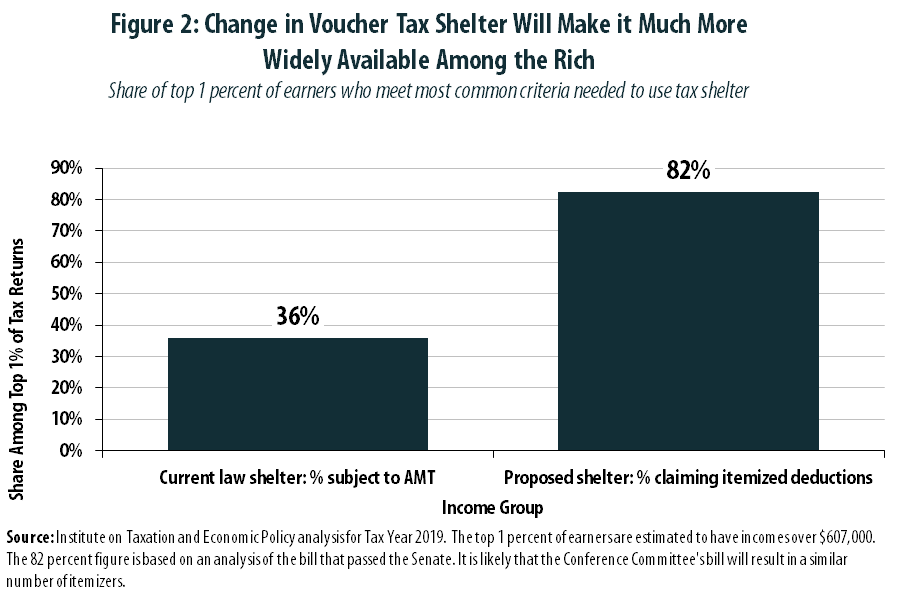
In its rush to pass a major rewrite of the tax code before year’s end, Congress appears likely to enact a “tax reform” that creates, or expands, a significant number of tax loopholes.[1] One such loophole would reward some of the nation’s wealthiest individuals with a strategy for padding their own bank accounts by “donating” to support private K-12 schools. While a similar loophole exists under current law, its size and scope would be dramatically expanded by the legislation working its way through Congress.[2]
How the House and Senate Tax Bills Would Affect Kansas Residents’ Federal Taxes
December 6, 2017 • By ITEP Staff
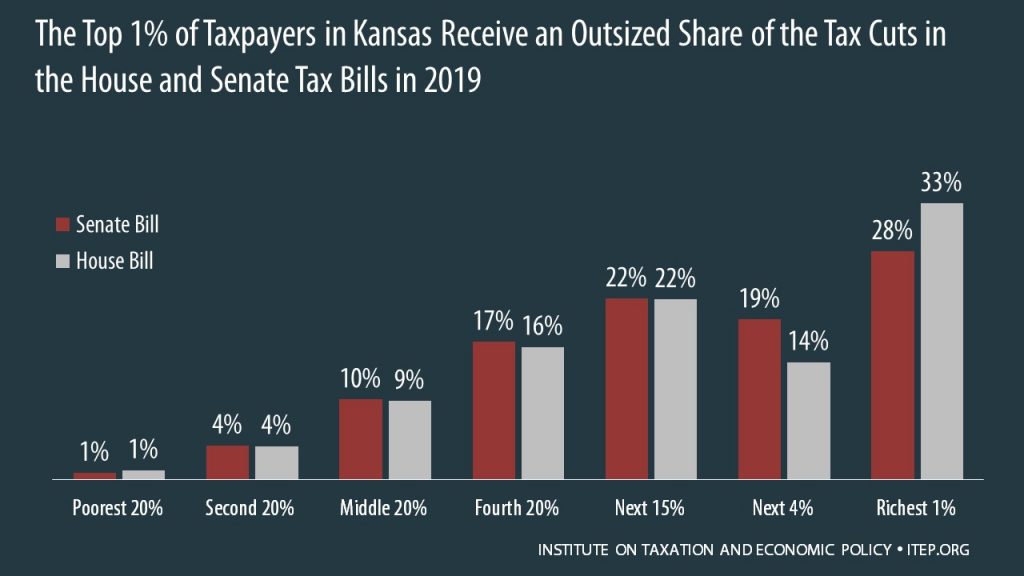
The House passed its “Tax Cuts and Jobs Act” November 16th and the Senate passed its version December 2nd. Both bills would raise taxes on many low- and middle-income families in every state and provide the wealthiest Americans and foreign investors substantial tax cuts, while adding more than $1.4 trillion to the deficit over ten years. The graph below shows that both bills are skewed to the richest 1 percent of Kansas residents.
How the Revised Senate Tax Bill Would Affect Kansas Residents’ Federal Taxes
November 14, 2017 • By ITEP Staff

The Senate tax bill released last week would raise taxes on some families while bestowing immense benefits on wealthy Americans and foreign investors. In Kansas, 46 percent of the federal tax cuts would go to the richest 5 percent of residents, and 8 percent of households would face a tax increase, once the bill is fully implemented.
How the House Tax Proposal Would Affect Kansas Residents’ Federal Taxes
November 6, 2017 • By ITEP Staff
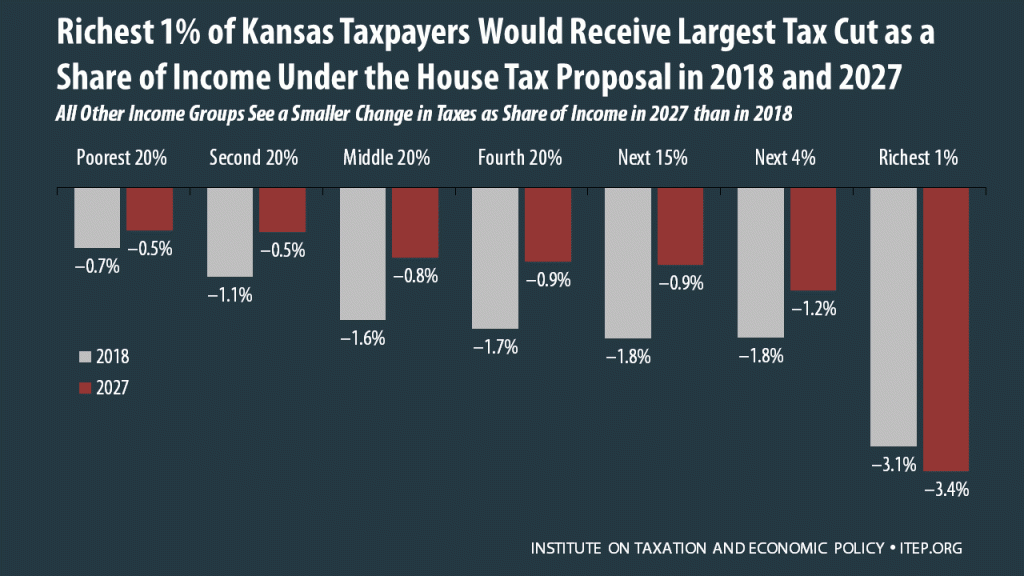
The Tax Cuts and Jobs Act, which was introduced on November 2 in the House of Representatives, includes some provisions that raise taxes and some that cut taxes, so the net effect for any particular family’s federal tax bill depends on their situation. Some of the provisions that benefit the middle class — like lower tax rates, an increased standard deduction, and a $300 tax credit for each adult in a household — are designed to expire or become less generous over time. Some of the provisions that benefit the wealthy, such as the reduction and eventual repeal of the estate…
State Rundown 10/4: Wildfires in Montana and Tax Cuts in Kansas Wreak Budget Havoc
October 4, 2017 • By ITEP Staff
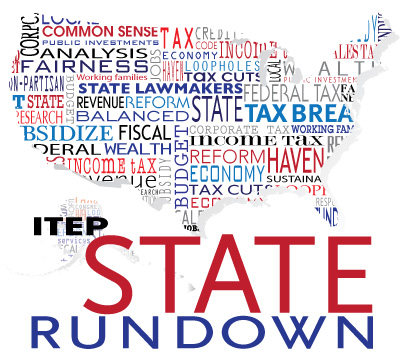
This week, Kansas's school funding was again ruled unconstitutionally low and unfair, while Montana lawmakers indicated they'd rather let historic wildfires burn a hole through their budget than raise revenues to meet their funding needs. Meanwhile, a struggling agricultural sector continues to cause problems for Iowa and Nebraska, but legalized recreational marijuana is bringing good economic news to both California and Nevada.
GOP-Trump Tax Framework Would Provide Richest One Percent in Kansas with 58.3 Percent of the State’s Tax Cuts
October 4, 2017 • By ITEP Staff
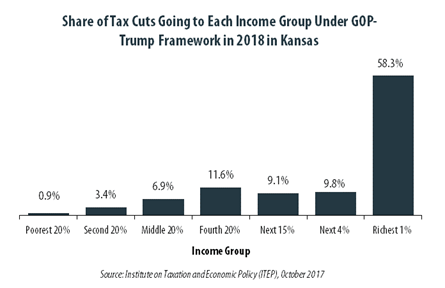
The “tax reform framework” released by the Trump administration and congressional Republican leaders on September 27 would not benefit everyone in Kansas equally. The richest one percent of Kansas residents would receive 58.3 percent of the tax cuts within the state under the framework in 2018. These households are projected to have an income of at least $535,600 next year. The framework would provide them an average tax cut of $84,190 in 2018, which would increase their income by an average of 4.6 percent.
